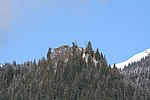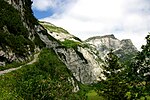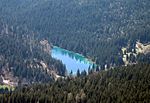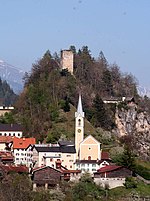Ringelspitz

The Ringelspitz (also known as Piz Barghis) is a mountain of the Glarus Alps, located on the border between the Swiss cantons of St. Gallen and Graubünden. Reaching a height of 3,248 metres above sea level, it is the highest summit in the canton of St. Gallen. It is split between three municipalities: Pfäfers (St. Gallen), Trin and Tamins (Graubünden). The Ringelspitz is the culminating point of a range, about 12 kilometres long, running from west to east and diverging from the main chain of the Glarus Alp between Piz Sardona and Piz Segnas. The massif separates the Calfeisen valley in canton St. Gallen from the Rhine valley near Flims. The north side of the mountain consists of nearly 2,000 metre-high precipitous cliffs overlooking the Gigerwaldsee (1,335 m).
Excerpt from the Wikipedia article Ringelspitz (License: CC BY-SA 3.0, Authors, Images).Ringelspitz
Geographical coordinates (GPS) Address Nearby Places Show on map
Geographical coordinates (GPS)
| Latitude | Longitude |
|---|---|
| N 46.898333333333 ° | E 9.3433333333333 ° |
Address
Tamins
7015
Grisons, Switzerland
Open on Google Maps








